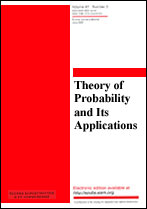|
|
Teoriya Veroyatnostei i ee Primeneniya, 1980, Volume 25, Issue 1, Pages 3–17
(Mi tvp943)
|
|
|
 |
This article is cited in 2 scientific papers (total in 2 papers)
Asymptotic behaviour of partial densities and their derivatives
D. M. Čibisov
Moscow
Abstract:
If $p(u_1,\dots,u_k)$ be a $k$-variate density then we call partial densities the functions
of a part of variables $u_1,\dots,u_k$ when remaining variables are fixed.
Let $(Y_{i0},Y_{1i},\dots,Y_{pi})$ for $i=1,\dots,n$ be i.i.d. random $(p+1)$-vectors,
$$
T_{nl}=n^{-1/2}\sum_{i=1}^nY_{li},\qquad l=0,1,\dots,p.
$$
Denote by $p_n(u_0,u_1,\dots,u_p)$ the density of
$(T_{n0},T_{n1},\dots,T_{np})$, let for
$\nu=0,1,\dots$
$$
p_n^{(\nu)}(u_0,u_1,\dots,u_p)=(\partial/\partial u_0)^\nu p_n(u_0,u_1,\dots,u_p).
$$
Given $p_1$, $0\le p_1<p$, let $\mathbf u_1=(u_0,\dots,u_{p_1})$,
$\mathbf u_2=(u_{p_1+1},\dots,u_{p})$,
$$
q_{n,\nu}(\mathbf u_2)=\sup[|p_n^{\nu}(\mathbf u_1,\mathbf u_2)|;\mathbf u_i\in R^{p_1+1}].
$$
It is proved under certain conditions that $q_{n,\nu}(\mathbf u_2)$ in some respects behaves like a density function. Namely, for any $\nu=0,1,\dots$
$$
\int_{R^{p-p_1}}q_{n,\nu}(\mathbf u_2)\,d\mathbf u_2\le C<\infty.
$$
Moreover, for an arbitrary $l_1$, $p_1+1\le l_1\le p$, consider the function
$$
Q_{n,\nu}(z)=\int_{u_{l_1}>z}q_{n,\nu}(\mathbf u_2)\,d\mathbf u_2.
$$
We obtain an upper bound for $Q_{n,\nu}(z)$ similar to that for $\mathbf P\{T_{n,l_1}>z\}$.
If the distribution of $(Y_{01},\dots,Y_{p1})$ satisfies the Cramér's condition (C) the above stated
results hold for appropriately smoothed version of $T_{n0},\dots,T_{np}$.
Received: 29.09.1978
Citation:
D. M. Čibisov, “Asymptotic behaviour of partial densities and their derivatives”, Teor. Veroyatnost. i Primenen., 25:1 (1980), 3–17; Theory Probab. Appl., 25:1 (1980), 1–15
Linking options:
https://www.mathnet.ru/eng/tvp943 https://www.mathnet.ru/eng/tvp/v25/i1/p3
|


|




 Contact us:
Contact us: Terms of Use
Terms of Use
 Registration to the website
Registration to the website Logotypes
Logotypes







 Citation in format
Citation in format 
